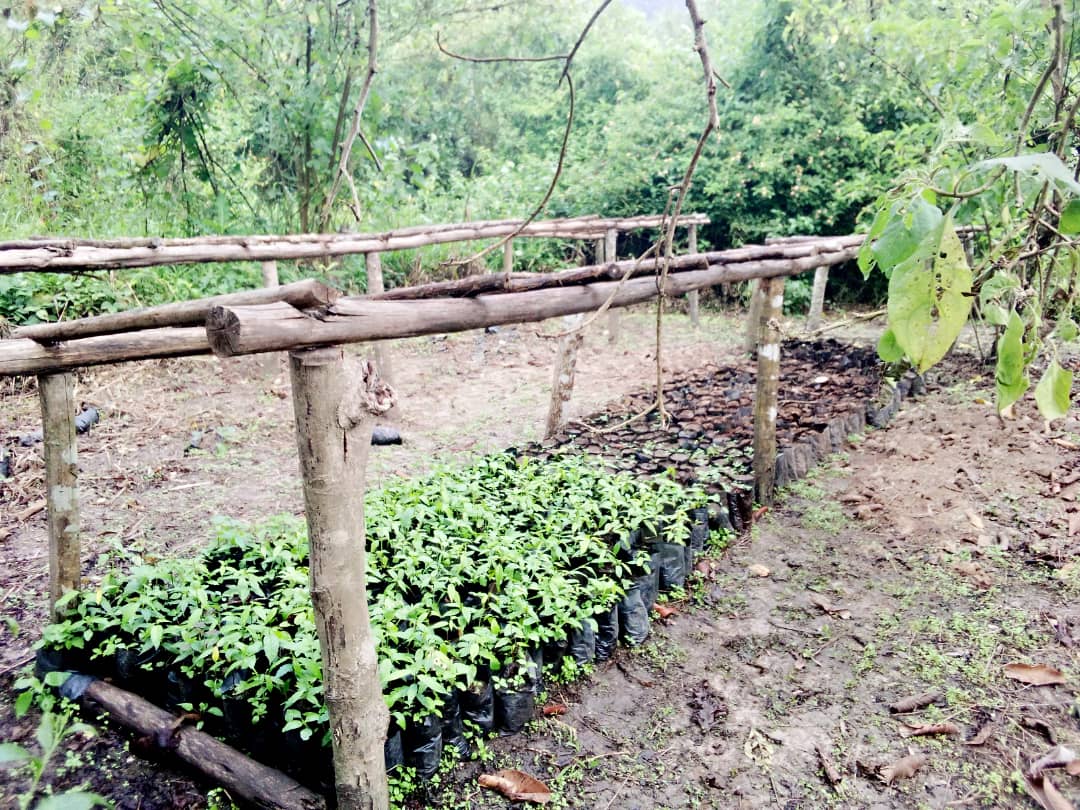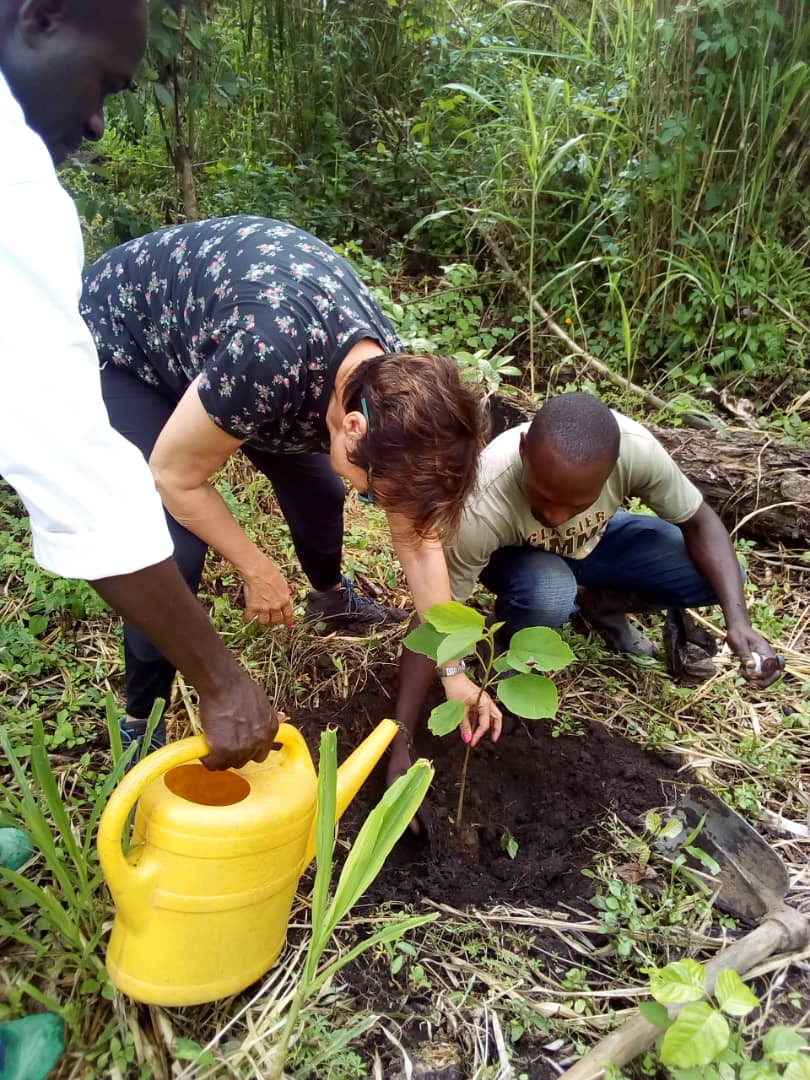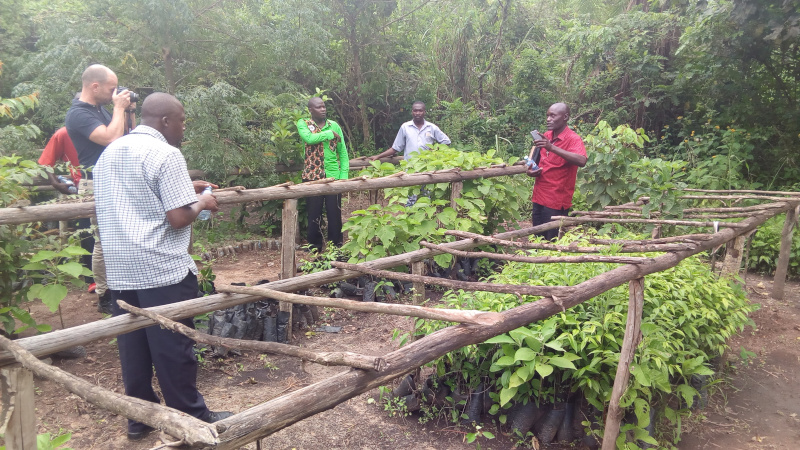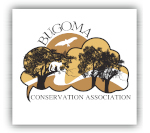Bugoma Nursery Bed and Tree Planting
The Bugoma Nursery bed and tree planting project was open in July 2016 in Nyakafunjo at the site of ACBF.
What are the objectives?
The objective is to avail to farmers and any other institutions typical indigenous tree seedlings which are not easily available in the area with the purpose of supporting agro-forestry and the protection of water sources. The nursery bed also plays a role as a stock of seedlings for the reforestation and restoration programs in the zone.
Problem statements
From the analysis in the area of our operations, the buffer zones of Bugoma Forest reserve, it is clear an increasing pressure on the forest reserve for biomass, timber, agricultural expansion as the major threats which affect the protection. In fact most of the area along the reserve boundary has been deforested for subsistence agriculture with little attention to keep any forest cover at all.
From our surveys carried out in Kabwoya sub-county in 2014, most of the people in the area are small scale subsistence farmers and job opportunities are scarce. Therefore, illegalities like charcoal making and illegal logging become an option for making economic benefits. Among the trees more targeted by illegal logging are mahogany, Nkorati, Kisanda, Omusanda and Omuhagu, for which there is high demand and no commercial market is available.

Another aspect is that pressure on water sources has increased due to a high rate of degradation and the level of water of the two main rivers (R. Nkusi and R. Rutoha) has decreased in the last few years causing a threat in the water supply. Moreover, from the chemical analysis of water, it was found that the water is highly contaminated due to sedimentation because of reducing forest cover and the increased number of cattle in the area. According to the law and the dispositions by the National Environmental Management Authority (NEMA), all rivers and water bodies in Uganda are supposed to be protected by allowing a covered buffer area of at least 30 meters from the water. However, very few buffer zones are actually maintained.
Through the work of sensitization done along the years from 2016 to date, the Association established a number of contacts with farmers and other institutions like public and private schools and churches (Catholic and Protestants), which is the basis for building up our conservation efforts. Engaging in tree planting, supporting agro-forestry, supporting valid alternative livelihood activities have been the purpose of the projects of the Association.
Why the nursery bed project?
The objective of the project is to protect the buffer zones areas of the water bodies by planting indigenous trees in collaboration with the households and to increase the capacity and knowledge by farmers to sustainably grow indigenous trees in agro-forestry activities like beekeeping.
The protection of the water bodies by rehabilitation of covered buffer zones gives the opportunity to introduce agro-forestry related activities like beekeeping, avails biomass for household consumption (firewood) and helps keeping the water clean, safe while also reducing soil erosion.
Furthermore, the public nursery bed provides a local source of indigenous seedlings in the area of Kabwoya Sub County to support reforestation and restoration projects, including the ACBF project Every 5 Acres.
The objective of the project is in line with the efforts to achieve the Sustainable Development Goals and in particular:

Goal 6. Ensure availability and sustainable management of water and sanitation for all. By 2020, protect and restore water-related ecosystems, including mountains, forests, wetlands, rivers, aquifers and lakes.

Goal 13. Take urgent action to combat climate change and its impacts.

Goal 15. Protect, restore and promote sustainable use of terrestrial ecosystems, sustainably manage forests, combat desertification and halt and reverse land degradation and halt biodiversity loss. By 2020, ensure the conservation, restoration and sustainable use of terrestrial and inland freshwater ecosystems and their services, in particular forests, wetlands, mountains and drylands, in line with obligations under international agreements. By 2020, promote the implementation of sustainable management of all types of forests, halt deforestation, restore degraded forests and substantially increase afforestation and reforestation globally.
The area of the project
The Association identified the project area in Igwanjura Parish of Kabwoya Sub County, where it is also found the nursery bed and where there are a number of water bodies in need of protection. According to our observations, the water level of various water bodies is decreasing due to general environmental degradation and encroachment of the same.

The project is targeting all the stakeholders / households living along the water bodies of the Parish and it is aimed at clearing the water bodies from encroachment, rehabilitating them and planting trees to reconstruct a buffer area of about 30 meters according to the law, to protect the water, so that soil erosion is reduced and water is maintained clean, also giving to farmers the opportunity to use biomass from their own land as well as the opportunity to start new activities like beekeeping.
Beneficiaries are small farmers in the area of Igwanjura Parish – bordering Bugoma Forest Reserve – which is composed by 7 villages: Nyakafunjo, Kyabayanja, Kyamujogo, Kasenene, Kyaruhaja, Kitanga and Kimunungu. This is the area where a number of water streams are located. We estimate a total number of 150 households living where the water banks are found, all objects of our intervention.
How this project works
The project includes: sensitization of the communities over the importance of maintaining the water bodies and to grow trees having forested covers; clearing of the water bodies from bush and encroachment; planting of indigenous trees seedlings along the water bodies; training of households on the maintenance of the seedlings; monitoring and evaluation along the period of one year to guarantee sustainability of the outcomes.
In order to serve the project, in 2016 the association opened a first public nursery bed as one of its activities in Nyakafunjo with an initial stock of about 1000 tree species, all indigenous forest trees. However, the demand for tree seedlings from local institutions and farmers grew and in 2017 and 2018 the nursery was stocking on the average 4000 seedlings. The tree species are selected among indigenous trees like: Prunus Africana, Albizia, Cordia Africana, musisi, Mahogany, Citrus Fruits, Neem tree.

The beneficiaries are small farmers in Kabwoya Sub-County and institutions like primary schools and churches. Seedlings are given to beneficiaries upon signing an “agreement”, which entitles them to receive the requested number and type of seedlings free of charge, but with the commitment to cater for the trees, to plant them in strategic areas where water sources can be protected, to be monitored by ACBF over the performance and to undergo training. A pre-assessment is made to establish the feasibility of the agreement by ACBF coordinators. ACBF also engages in providing monitoring and training opportunities on how to maintain trees.
Achievements : beneficiaries of the project since 2016 were able to be supported with constant supply for trees for their farms, to increase agro-forestry practices and beekeeping. Part of the water streams in the project area were subject to tree planting exercises, which increase peoples awareness and protection of the water sources and against soil erosion.
Why to donate to the nursery bed project
The Bugoma nursery bed requires constant funds as it is not a self sustainable program. The tree seedlings have to be stocked every new season (twice a year), the maintenance of the nursery provided by ACBF personnel, the tree planting exercises provided in the area of the project, as well as transportation, monitoring and training work.
The cost of this project is 4.500 US Dollars per year.
 ACBF
ACBF